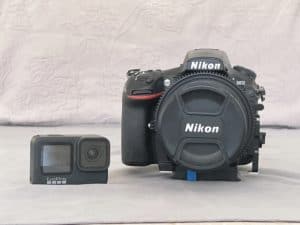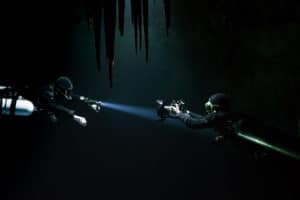Underwater ocean photography can be a thrilling and rewarding experience for both novice and experienced scuba divers.
Capturing the beauty and mystery of the underwater world requires a different approach than land-based photography, and there are many factors to take into account when getting started with underwater photography. From the gear you need, to setting up the shot, it’s not quite as simple as pointing the camera and clicking…
In this blog post, we will explore some important tips and considerations for beginner underwater photographers.
What To Take into Account When It Comes To Underwater Ocean Photography
Before diving into underwater photography (pun intended), there are several things you need to consider.
Be A Confident Scuba Diver
Underwater photography requires you to be able to maintain a stable position, adjust your buoyancy, and handle your equipment without compromising your safety or the safety of the marine environment.
Many novice divers are keen to share pictures and vistas of the underwater world with their on-land friends, with many questions on scuba forums asking for recommendations for the ‘best underwater camera’, when they haven’t even finished their open water course.
Until you are confident with your ability and can manage your equipment and buoyancy on a dive well, you shouldn’t be thinking about underwater photography. This is for your own safety.
Instead, if you are desperate to have photographs of your wonderful dive, why not consider hiring a guide specifically for photography?

Choose The Right Equipment
Underwater photography has moved on in recent years, and many developments have made it more accessible for many people. There are now different options for underwater cameras, with some great for people on a budget, handy action cams, and even cases that can adapt your phone to be used under the deep blue.
As well as a waterproof camera, you’ll also need housing, strobes or lights, and other accessories such as lenses, filters, and memory cards. The camera and housing should be compatible for the camera you have, and these often cost as much, or if not more than the camera itself. Do your research and choose equipment that suits your level of experience and budget.
GoPro vs Photo Camera
One of the most common questions that beginner underwater photographers ask is whether to use a GoPro or a traditional photo camera. Both types of cameras have their advantages and disadvantages. GoPro cameras are compact, easy to use, and relatively affordable.
They are ideal for capturing action pictures and videos, and are popular among divers who want to document their dives without the added complexity of a more advanced camera system. Even if they say waterproof, you’ll still want to have the housing for them, in case you go deeper than the permitted depth.
However, if you’re serious about underwater photography, a dedicated camera system with interchangeable lenses and manual controls will give you much more creative freedom and better image quality. These cameras are more expensive and require more skill and experience to be used effectively, but the results can be stunning.

Buoyancy
Buoyancy control is one of the most important skills to master in underwater photography. The key is to be able to maintain a stable position when lining up your shot while minimizing your impact on the marine environment – perfect neutral buoyancy.
Being able to dive with great buoyancy requires practice and patience, but it’s essential for capturing clear, sharp images. You should also be aware of your body position and how you would swim while holding a camera rig, as this will affect your stability too.
Underwater Photography Course
If you’re new to underwater photography, it can be helpful to have a guide or instructor who can provide tips and advice on camera settings, composition, and lighting.
Many dive operators, like us here at DivePoint, offer specialized underwater photography courses and guided dives that cater to underwater photographers. These can be a great way to improve your skills and learn from experienced photographers.

Camera in Cenotes
As we are in Mexico, home of the amazing cenotes, we’re also going to consider the difference in underwater photography there too! Cenotes are unique and stunning underwater environments that offer a wealth of photographic opportunities.
In cenotes though, there is a lot less light, and your normal GoPro, or a camera without incredibly bright strobes won’t be able to pick up on the immense details in the rock formations.
It’s also important to be aware of the rules and regulations that govern diving and photography in cenotes. Some cenotes may charge an additional fee for allowing you to take a camera for photography, and some may prohibit photography altogether.
When diving in cenotes, your guide is not allowed to take photos or videos during the dive, so if this is something you wish to happen, discuss it with us before your dive.

Tips For Becoming a Better Underwater Photographer
There are a few more tips and considerations that beginner underwater photographers should keep in mind:
Practice, practice, practice: underwater photography is a skill that requires practice and patience. Don’t be discouraged if your first few attempts don’t turn out as you hoped. Keep practicing and experimenting with different techniques and settings.
Be a good buddy: if you’re buddies up on a dive with someone who isn’t there for the photos, be a good dive buddy and make them aware that you’re there to grab some great shots. This way they will know to give you time, and that you may be in one place for a while to line up the right picture.
Lighting is key: underwater lighting can be challenging, but it’s essential for capturing clear and vibrant images. Consider investing in a strobe or underwater light to help illuminate your subjects.
Think about composition: just like on land, the composition is an important element of photography underwater. Think about the placement of your subject, the background, and the overall balance of the image.
Be mindful of marine life: as an underwater photographer, you have a responsibility to respect and protect the marine environment. Be aware of your movements and avoid touching or disturbing marine life.
Don’t forget about post-processing: editing your photos after the dive can help bring out their full potential. Experiment with different editing techniques and software to enhance your images.
By keeping these tips in mind and practicing regularly, beginner underwater photographers can develop their skills and capture stunning images of the underwater world.

Let’s Go Take Some Underwater Photographs with DivePoint Mexico
Underwater photography can be a challenging but incredibly rewarding pursuit for scuba divers. There is nothing more special than showing the beauty of the world beneath the waves with land-loving friends and family.
By taking the time to learn the necessary skills and choosing the right equipment, you can capture stunning images of the underwater world. Remember to always prioritize safety and respect the marine life you see.
If you want to go diving to focus on photography, let us arrange a trip for you to either the ocean or the stunning cenotes. We can also support you to learn more about photo composition and make the most out of your camera with the PADI Underwater Photography Course.
We hope you liked this blog post on Underwater Photography.
What camera set-up do you use to take photos underwater?
If you enjoyed reading, make sure to read our other blog topics, leave us a comment, or follow us on our Facebook & Instagram pages!


